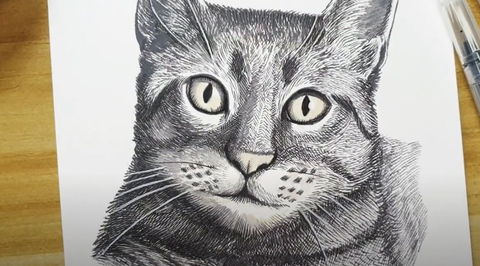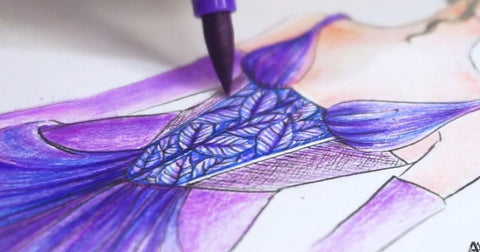Into The Creative Mind of Claude Monet: His Art, Style, and Story
Last Updated: July 29, 2024
If you’ve studied Impressionism or are interested in using impressionist themes in your artworks, then you’ve probably heard of Claude Monet.
In the pantheon of art history, few names evoke the essence of Impressionism as profoundly as Oscar-Claude Monet. His paintings, renowned for their vivid colors, light-filled landscapes, and unique style, continue to captivate audiences worldwide.

Claude Monet's "Self Portrait with a Beret" (1886)
But beyond the strokes of his brush lies a narrative of perseverance, innovation, and an insatiable passion for capturing the essence of nature. Let’s dive into the kaleidoscopic world of Claude Monet and uncover the intricacies of his art, style, and the story that shaped this titan of art.
Inspiration by Sea: Early Years and Influences

Cliff Walk at Pourville (1882)
Born on November 14, 1840, in Paris, Oscar-Claude Monet’s journey as an artist began with a strong penchant for capturing nature's nuances. In 1841, he and his family moved from Paris to Le Havre, a coastal town in Normandy, France.
As the second son of Claude-Adolphe and Louise-Justine Aubrée Monet, his father wanted him to take over the family business of selling groceries. But young Claude had different aspirations. His upbringing in Le Havre gave him an abiding love for the play of light on water. The rugged coastline and the ocean of Northern France affected him profoundly, and even now, his works reflect this influence.

Caricature of Léon Manchon (1855-56)
Following his love for art, Monet entered the Le Havre secondary school of the arts in April of 1851. Jacques-François Ochard, former student of Jacques-Louis David, gave him his first drawing lessons. Then, between 1856-57, he met artist Eugène Boudin, who taught him oil painting and “en plein air” (outdoor) painting techniques.
|
Did you know? Monet’s first claim to (local) fame was his charcoal caricatures which often sold for 10-20 francs.
|
But Monet’s life is not without tragedy. At the age of 15, he lost his mother, and at 16, he left school to live with his widowed aunt, Marie-Jeanne Lecadre. Still, the support he received from his family and friends continued to encourage him to pursue his passion for art.
The Evolution of Style: Capturing the ‘Impression’
Even at a young age, Monet was already setting himself apart from other artists at the time.
Case in point: He traveled to Paris to visit The Louvre and saw that painters there only copied what the old masters did. But instead of trying to fit in, Monet would choose to sit by a window and, with paints and tools on hand, paint whatever he saw.

Women in the Garden (1866-67)
Obligated to join the army, Monet traveled to Algeria for what was supposed to be a seven-year deployment. But after two years of staying there, he contracted typhoid, and his aunt intervened to get him out. In exchange, he enrolled in an art course at a university, but became disillusioned instead of the traditional techniques taught there.
Monet’s artistic journey took a significant turn in the mid-1860s when he became a student of Charles Gleyre and met fellow students Frédéric Bazille, Pierre-Auguste Renoir, and Alfred Sisley.
Their collective genius ushered in a revolutionary movement in the art world – Impressionism. This avant-garde movement sought to capture the fleeting essence of a moment, particularly in the open air, emphasizing the play of light, colors, and atmosphere over distinct details.
The term 'Impressionism' stemmed from Monet’s painting “Impression, Sunrise,” exhibited in 1874. Critics initially used the title mockingly, yet this very term became the moniker for the movement that would reshape the art world.

Impression Sunrise (1872)
Monet’s technique was not about rendering an exact replica of reality but rather about conveying the sensation or 'impression' of a scene. His brushwork, characterized by quick, broken strokes, aimed to capture the transient quality of light, weather, and movement.
His fascination with light and its effects on different subjects led to a series of paintings that depicted the same scene in different light and weather conditions, like his famed "Haystacks" and "Water Lilies" series.
From the Clutches of Grief to A Sanctuary of Inspiration
About a year before the Franco-Prussian War broke out in July 1870, Monet married Camille Doncieux, one of his early painting models and the inspiration for his famous piece, “The Woman in the Green Dress” (1866). Sadly, the lady became ill in 1876 and, about a year after she gave birth to their second son, died of tuberculosis.
|
Did you know? Claude Monet painted his wife when she was dying. Titled “Camille Monet on Her Deathbed,” (1879) it remains one of the most powerful and poignant expressions of love from Claude to his wife. |

Camille Monet on Her Deathbed (1879)
Monet channeled his grief into his art and continued to make paintings that showcased the French countryside in an Impressionist light. Eventually, he and his sons moved into the home of one Ernest Hoschedé, with his wife and six children, in Vétheuil.
Hoschedé was a wealthy department store owner and an art aficionado. But when he went bankrupt in 1878, he abandoned his family to depart for Belgium, leaving Alice (his wife) to take care of their six children. After several years of packing up and moving, Monet eventually chanced upon a house and two acres of land in the sleepy town of Giverny. With Alice and the eight children in tow, Monet moved in.
The latter part of Monet's life was spent in Giverny, where he meticulously designed his garden and pond, which became the central focus of his artistic exploration. The water lilies, the Japanese bridge, and the flowers became not just his subjects but a living canvas for his ceaseless exploration of light and color.
Moreover, the views and landscapes in Giverny gave way to his series paintings – artworks with a common subject or theme, depicted in varying weather conditions and light. Among his notable series artworks are the Houses of Parliament, Mornings on the Seine, Poplars, Rouen Cathedral, and his most famous ones, the Water Lilies.

A Master of Light and Color
Claude Monet’s legacy extends far beyond the art world. His indelible impact on modern art, particularly through Impressionism, laid the groundwork for countless artists and movements that followed.
Claude Monet's art was a symphony of colors and light, a testament to his unwavering dedication to portraying the ephemeral beauty of the world. His legacy endures, not just in his paintings but in the very essence of his approach - an unyielding commitment to artistic vision and an unrelenting pursuit of capturing the ever-shifting facets of nature.

Haystacks (1890-91)
Truly, his innovative approach to painting and his relentless pursuit of capturing the ever-changing qualities of light and nature continue to inspire artists and art enthusiasts globally.
Claude Monet's story continues to resonate with artists and art enthusiasts, illuminating the path for creative expression and innovation. As marvel at the enchanting strokes of Monet’s brush, we are reminded that at the very core of it lies a visionary mind that transformed the way we perceive and interpret the world around us.
We hope this journey into the life, art, and times of Claude Monet inspired you to take up your brush and create your next masterpiece. If you'd like more ideas and inspiration, check out The Creative Corner for all things art. Creativity awaits!






